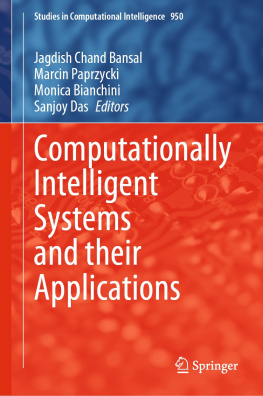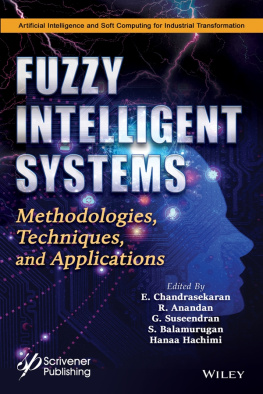Volume 102
Intelligent Systems, Control and Automation: Science and Engineering
Series Editor
Kimon P. Valavanis
Department of Electrical and Computer Engineering, University of Denver, Denver, CO, USA
Advisory Editors
P. Antsaklis
University of Notre Dame, Notre Dame, IN, USA
P. Borne
Ecole Centrale de Lille, France
R. Carelli
Universidad Nacional de San Juan, Argentina
T. Fukuda
Nagoya University, Japan
N. R. Gans
The University of Texas at Dallas, Richardson, TX, USA
F. Harashima
University of Tokyo, Japan
P. Martinet
Ecole Centrale de Nantes, France
S. Monaco
University La Sapienza, Rome, Italy
R. R. Negenborn
Delft University of Technology, The Netherlands
Antnio Pascoal
Institute for Systems and Robotics, Lisbon, Portugal
G. Schmidt
Technical University of Munich, Germany
T. M. Sobh
University of Bridgeport, CT, USA
C. Tzafestas
National Technical University of Athens, Greece
Intelligent Systems, Control and Automation: Science and Engineering book series publishes books on scientific, engineering, and technological developments in this interesting field that borders on so many disciplines and has so many practical applications: human-like biomechanics, industrial robotics, mobile robotics, service and social robotics, humanoid robotics, mechatronics, intelligent control, industrial process control, power systems control, industrial and office automation, unmanned aviation systems, teleoperation systems, energy systems, transportation systems, driverless cars, human-robot interaction, computer and control engineering, but also computational intelligence, neural networks, fuzzy systems, genetic algorithms, neurofuzzy systems and control, nonlinear dynamics and control, and of course adaptive, complex and self-organizing systems. This wide range of topics, approaches, perspectives and applications is reflected in a large readership of researchers and practitioners in various fields, as well as graduate students who want to learn more on a given subject.
The series has received an enthusiastic acceptance by the scientific and engineering community, and is continuously receiving an increasing number of high-quality proposals from both academia and industry. The current Series Editor is Kimon Valavanis, University of Denver, Colorado, USA. He is assisted by an Editorial Advisory Board who help to select the most interesting and cutting edge manuscripts for the series:
Panos Antsaklis, University of Notre Dame, USA
Stjepan Bogdan, University of Zagreb, Croatia
Alexandre Brandao, UFV, Brazil
Giorgio Guglieri, Politecnico di Torino, Italy
Kostas Kyriakopoulos, National Technical University of Athens, Greece
Rogelio Lozano, University of Technology of Compiegne, France
Anibal Ollero, University of Seville, Spain
Hai-Long Pei, South China University of Technology, China
Tarek Sobh, University of Bridgeport, USA
Springer and Professor Valavanis welcome book ideas from authors. Potential authors who wish to submit a book proposal should contact Thomas Ditzinger (thomas.ditzinger@springer.com)
Indexed by SCOPUS, zbMATH, SCImago.
Editors
Maria Isabel Aldinhas Ferreira
Centro de Filosofia, Universidade de Lisboa, Lisbon, Portugal
Mohammad Osman Tokhi
School of Engineering, London South Bank University, London, UK
ISSN 2213-8986 e-ISSN 2213-8994
Intelligent Systems, Control and Automation: Science and Engineering
ISBN 978-3-031-09822-2 e-ISBN 978-3-031-09823-9
https://doi.org/10.1007/978-3-031-09823-9
The Editor(s) (if applicable) and The Author(s), under exclusive license to Springer Nature Switzerland AG 2022
This work is subject to copyright. All rights are solely and exclusively licensed by the Publisher, whether the whole or part of the material is concerned, specifically the rights of translation, reprinting, reuse of illustrations, recitation, broadcasting, reproduction on microfilms or in any other physical way, and transmission or information storage and retrieval, electronic adaptation, computer software, or by similar or dissimilar methodology now known or hereafter developed.
The use of general descriptive names, registered names, trademarks, service marks, etc. in this publication does not imply, even in the absence of a specific statement, that such names are exempt from the relevant protective laws and regulations and therefore free for general use.
The publisher, the authors, and the editors are safe to assume that the advice and information in this book are believed to be true and accurate at the date of publication. Neither the publisher nor the authors or the editors give a warranty, expressed or implied, with respect to the material contained herein or for any errors or omissions that may have been made. The publisher remains neutral with regard to jurisdictional claims in published maps and institutional affiliations.
This Springer imprint is published by the registered company Springer Nature Switzerland AG
The registered company address is: Gewerbestrasse 11, 6330 Cham, Switzerland
Preface
People have little reason to turn away from machines; which are nothing other than hyperdeveloped and hyperconcentrated forms of certain aspects of human subjectivity [] it will be possible to build a two-way bridge between human beings and machines and, once we have established that, to herald new and confident alliances between them.
Felix Guatari
Artificial intelligent systems, in either embodied or non-embodied forms, have been increasingly permeating multiple domains in the economic, social and cultural environments that characterize the present lived reality. And though this reality may be distinct depending on the regional context, the human intertwining with technology is a horizontal phenomenon common to all.
Innovation is driven by the very evolution of society and by its goal to address the needs of its members fostering wealth and individual and collective physical and psychological well-being. This goal is actually present in the 3 Ds motto that for decades has been driving robotic research and development: to free human beings from dangerous, dirty and dull tasks.
Millions of end-users, of consumers have been responding positively to the technological development first made possible by electricity and mass production, in the early twentieth century, happily adopting the lifestyle changers that became the average consumer dreams: a new TV set, a huge refrigerator, a dishwashing machine, the latest car version, new services and envisioning the robotic butler that would perform all the dull tasks in the domestic universe.
On its side, industry and business fed and driven by the demands of a very fast-growing market have tried to define the different potential end-users profiles not only to better respond to their interests and needs but also to foster new interests and new needs, even when these were/are totally superfluous. Consumers have been embracing innovation, incorporating it in their daily lives, considering the objects, the services at their disposal as trustworthy, because they assume them as risk free.















